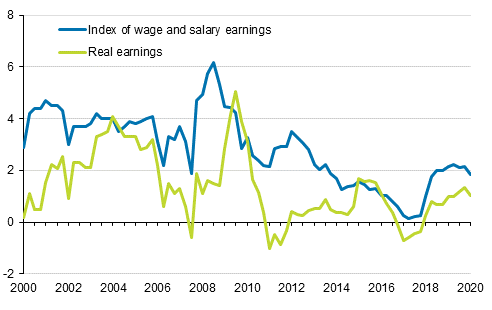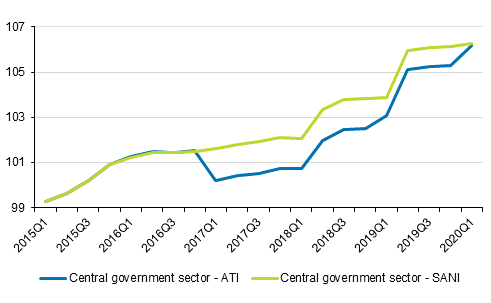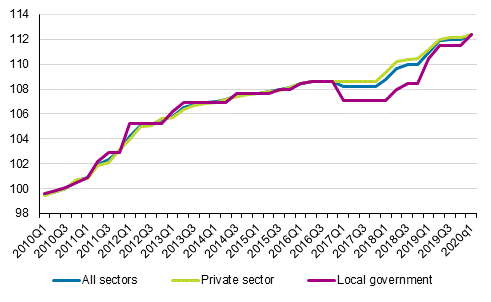Published: 28 May 2020
Wage and salary earners’ earnings for regular working hours rose by 1.8 percent in January-March
According to preliminary data of Statistics Finland, the index of wage and salary earnings, which measures the development of nominal earnings of full-time wage and salary earners, rose by 1.8 per cent in January to March 2020 when compared with the respective period in 2019. Real earnings rose by 1.0 per cent compared to the first quarter of the previous year, because the rise in earnings level was faster than that in consumer prices.
Index of wage and salary earnings and real earnings 2000/1 to 2020/1, annual change percentage

According to Statistics Finland’s preliminary data, the nominal earnings of full-time wage and salary earners rose from January to March 2019 to the corresponding period in 2020 by 1.6 per cent in the private sector, by 3.0 per cent in the central government sector and by 2.3 per cent in the local government sector.
The index of regular earnings increased by 1.6 per cent in January to March
The index for regular earnings describes the permanent change in earnings better than the index of wage and salary earnings because it does not take into account performance-based bonuses and non-recurring items included in collective agreements. The index of regular earnings rose by 1.6 per cent in January to March 2020 when compared with the respective period in 2019. The growth amounted to 1.6 per cent in the private sector, to 2.3 per cent in the central government sector, and to 1.5 per cent in the local government sector.
Effect of the Competitiveness Pact visible in earnings development
It was agreed in the Competitiveness Pact that public sector holiday bonuses would be reduced by 30 per cent in the years 2017 to 2019. The cuts in holiday bonuses ended after summer 2019. The cuts in holiday bonuses and their ending are visible in the development of the index of wage and salary earnings in the local government and central government sectors in 2017 and 2020.
Development of the index of wage and salary earnings and the index for regular earnings 2015=100

The figure examines the development of the index of wage and salary earnings (ATI) and the index for regular earnings (SANI) in the central government sector in 2015 to 2020. The examination ends in the latest published quarter, that is, the first quarter of 2020. The cuts in holiday bonuses are visible in the index of wage and salary earnings, which fell in the first quarter of 2017 and the earnings development was negative in 2017. Correspondingly, the ending of the cuts in holiday bonuses after summer 2019 turns the central government’s index of wage and salary earnings upwards at the beginning of 2020.
The indices for 2020 are based on the effects of agreements and the wage drift
The indices are final as far as the year 2018 and they are based on final wage statistics. The indices for 2019 are still preliminary. They are based on final wage statistics and in addition to the effects of agreements and the wage drift. The indices for 2020 are based on the effects of agreements and the wage drift.
For the time being, the effects of the exceptional situation caused by coronavirus have only been assessed in the index of wage and salary earnings for the wage drift data for 2020 in certain industries. The Tieto&trendit blog Wages and salaries diminished in April 2020 – the Incomes Register taking serious action (in Finnish only) gives background information on how the wage and salary figures available from the national Incomes Register reflect the exceptional situation caused by coronavirus.
Increases based on collective agreements are visible in the index of negotiated wages
The index of negotiated wages and salaries contains data on general increases based on collective agreements, local sectoral allowances, agency-specific items and non-recurring items. The figure examines the development of the index of negotiated wages and salaries 2010=100 in 2010 to 2020. Employer sectors total, private sector and local government sector were selected to the examination.
Development of the index of negotiated wages and salaries 2010=100 by employer sector

The local government sector's collectively bargained increments for 2020 were not yet known during the production of the first quarter of the index of wage and salary earnings. In the local government sector, the index of negotiated wages and salaries, however, rises at the beginning of 2020, because the reduction in public sector holiday bonuses ended and it is also visible in the development of the index of negotiated wages and salaries. Correspondingly, the index of negotiated wages and salaries in the local government sector fell in the first quarter of 2017 when the cuts in holiday bonuses took effect.
In 2017, the index of negotiated wages and salaries in the local government sector remained unchanged and made an upturn in the second quarter of 2018. The rise continued at the beginning of 2019, when a separate non-recurring item based on performance was paid in the local government sector, which was 9.2 per cent of the monthly pay of a wage and salary earner entitled to a non-recurring item. In addition, local government sector wages and salaries were raised by local sectoral allowances in January 2019 and by the general increase in April 2019.
In the central government sector, the development of the index of negotiated wages and salaries has in recent years largely followed the index of negotiated wages and salaries in the local government sector. The result of the negotiations was reached in the central government sector at the end of March and central government wages and salaries will be raised by the general increase in August, that is, in the third quarter of 2020. In the private sector, the times of pay rises vary by collective agreement sector and therefore the rise in the negotiated wages and salaries is more even during the year. However, in recent years the rise has often been focused on the early part of the year in the private sector as well.
Source: Index of wage and salary earnings 2020, 1st quarter. Statistics Finland
Inquiries: Anu Uuttu 029 551 2322, Harri Nummila 029 551 3235, palkat.indeksit@stat.fi
Director in charge: Mari Ylä-Jarkko
Publication in pdf-format (473.7 kB)
- Tables
-
Tables in databases
Pick the data you need into tables, view the data as graphs, or download the data for your use.
Appendix tables
- Appendix table 1. Index of wage and salary earnings 2015=100 by employer sector and base of payment (28.5.2020)
- Appendix table 2. Index of regular earnings 2015=100 by employer sector and base of payment (28.5.2020)
- Appendix table 3. Index of wage and salary earnings 2015=100 by employer sector and gender (28.5.2020)
- Appendix table 4. Index of regular earnings 2015=100 by employer sector and gender (28.5.2020)
- Appendix table 5. Index of wage and salary earnings 2015=100 by industry, (TOL 2008) (28.5.2020)
- Appendix table 6. Index of regular earnings 2015=100 by industry, (TOL 2008) (28.5.2020)
- Appendix table 7. Index of wage and salary earnings 2010=100 by employer sector and gender (28.5.2020)
- Appendix table 8. Index of wage and salary earnings 2010=100 by industry, (TOL 2008) (28.5.2020)
- Appendix table 9. Index of wage and salary earnings 2015=100, percentage changes (28.5.2020)
- Appendix table 10. Index of regular earnings 2015=100, percentage changes (28.5.2020)
- Appendix table 11. Average earnings by employer sector and gender, EUR/month (Appendix table was corrected on 16 June 2020. The corrected numbers are indicated in red) (28.5.2020)
- Revisions in these statistics
-
- Revisions in these statistics (28.5.2020)
Updated 28.5.2020
Official Statistics of Finland (OSF):
Index of wage and salary earnings [e-publication].
ISSN=1798-7814. 1st quarter 2020. Helsinki: Statistics Finland [referred: 19.4.2025].
Access method: http://stat.fi/til/ati/2020/01/ati_2020_01_2020-05-28_tie_001_en.html

